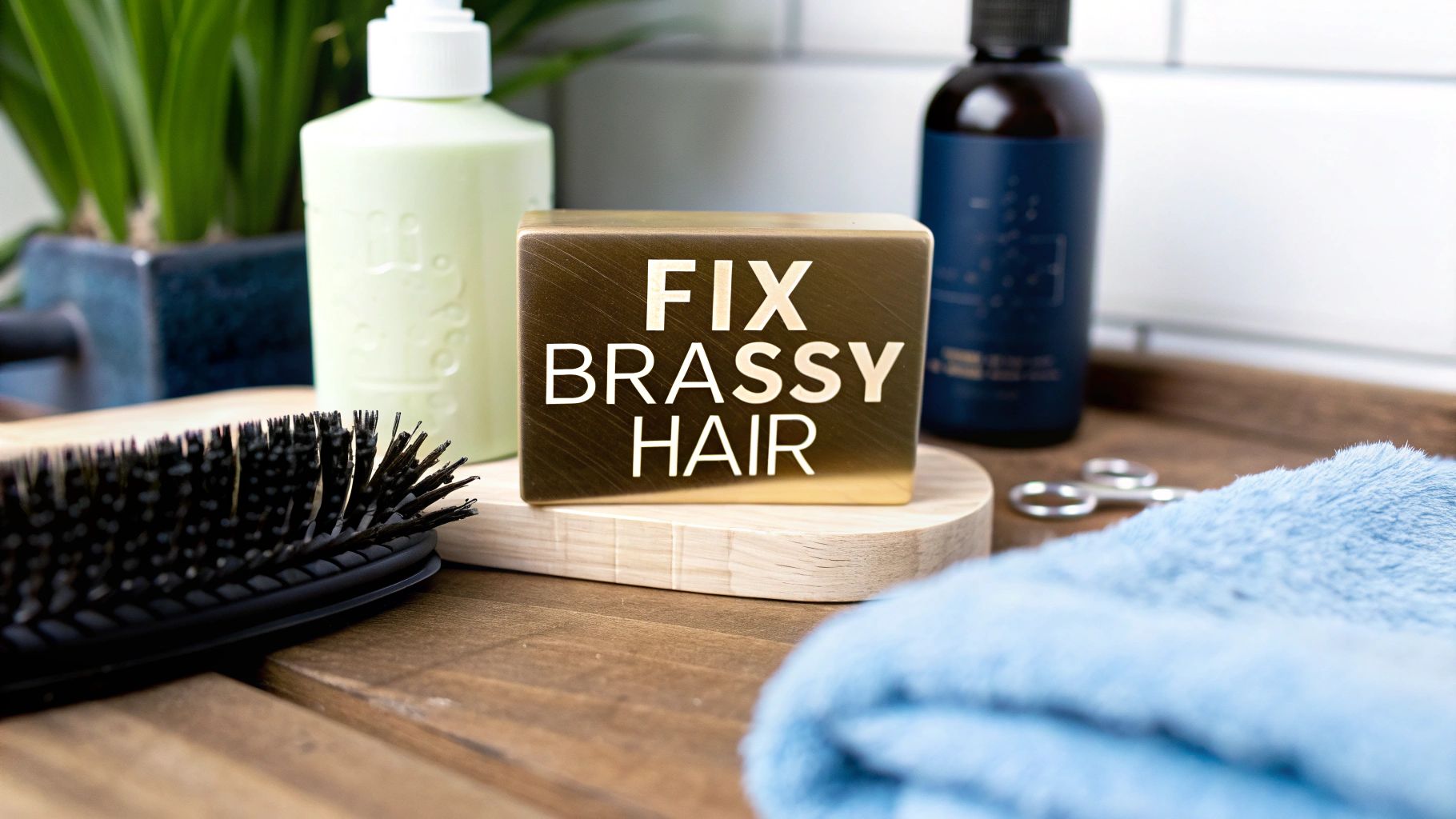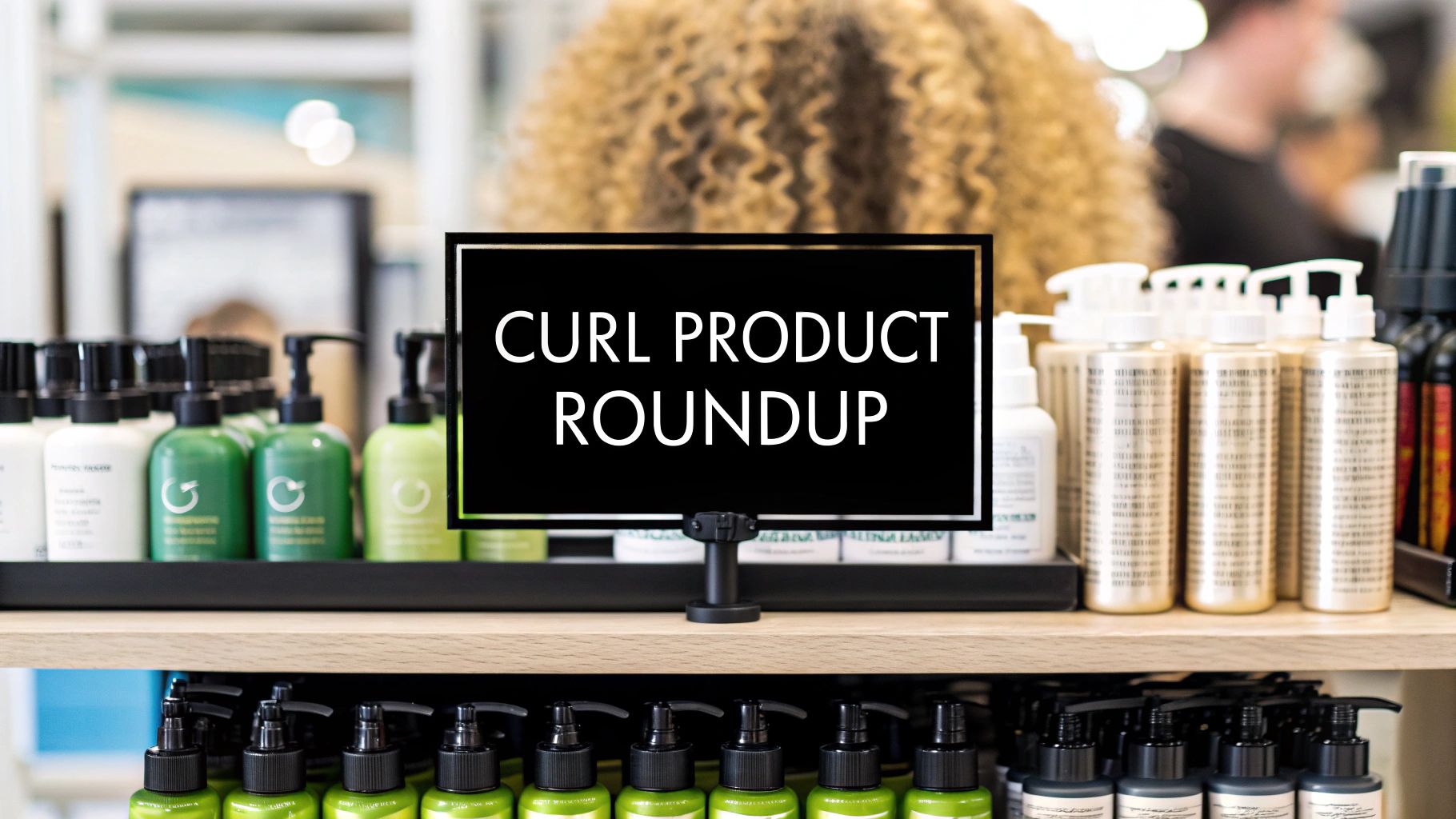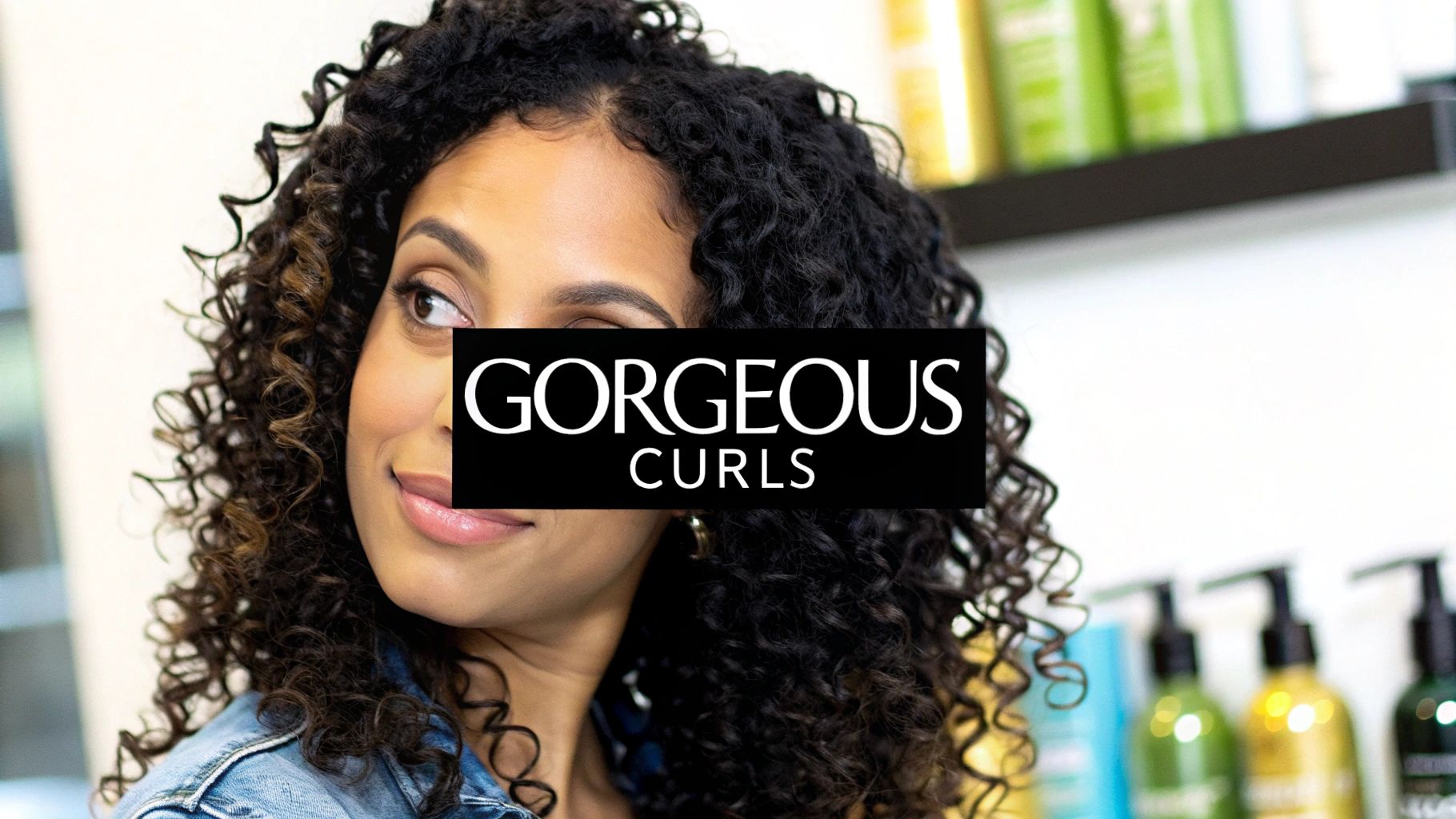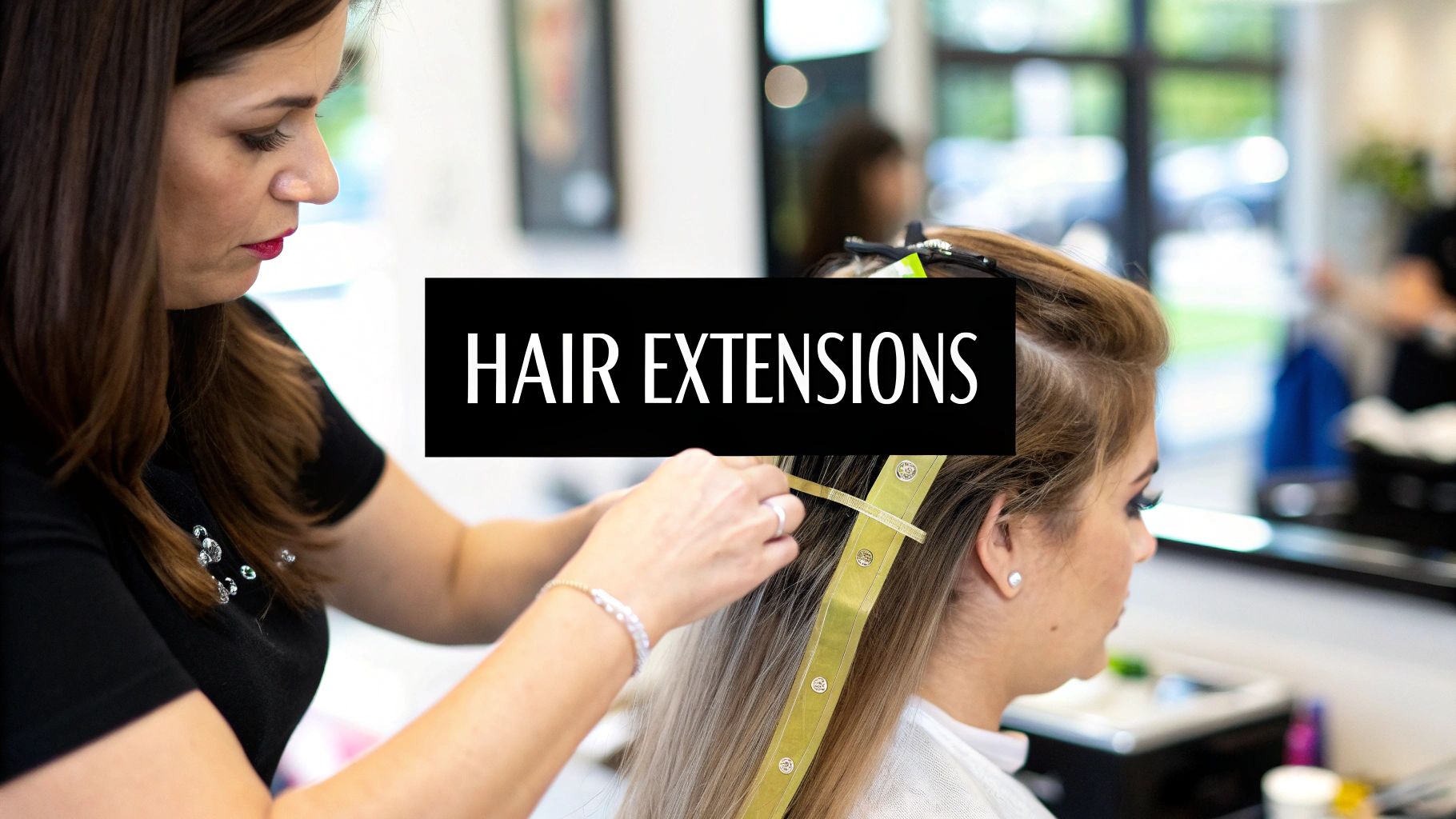So, you’ve noticed some unwelcome warmth creeping into your beautifully colored hair. Don’t panic—this is one of the most common hair color challenges out there, and it’s completely fixable. At its core, getting rid of brassiness is all about color theory. If you're seeing yellow tones in your blonde, a purple shampoo or toner will be your best friend. For those with lightened brunette hair fighting off orange, you'll want to reach for a blue-toned product. It’s that simple.
Thank you for reading this post, don't forget to subscribe!So, Why Does Hair Turn Brassy Anyway?
Before we dive into the fixes, it helps to understand what’s actually happening to your hair. Brassy tones aren't the result of a botched color job; they're just a natural part of the hair-lightening journey. Think of it this way: when you lighten your hair, you’re stripping away the natural color molecules.
Darker hair has a whole spectrum of underlying pigments—red, orange, and yellow. As bleach works its magic, it lifts your natural color and uncovers these warm tones. If the hair isn't lightened enough to get past that stage, or if the initial toner has faded, those underlying pigments will start to peek through.
The Color Science Behind It All
This all comes down to the basic science of hair color. Every natural shade has a hidden warm undertone that’s revealed during the lightening process.
- Darkest Hair: Hides red undertones.
- Medium Brown Hair: Sits on top of orange undertones.
- Lighter Hair: Has a base of yellow undertones.
When you go lighter, you're essentially exposing this underlying warmth. A stylist neutralizes it with a toner right after your service, but that toner isn't permanent. It gradually washes out, and the brassiness returns. And you're not alone in this—over 60% of people who color their hair say they struggle with unwanted warmth after leaving the salon. You can get a better sense of the industry trends by checking out the hair lightening product market report.
The truth is, you can't stop brassiness from happening forever. The real goal is to learn how to manage it with a solid at-home routine that keeps your color looking fresh and cool between salon appointments.
Building Your At-Home Anti-Brass Toolkit
Let's be real—keeping your hair color fresh between salon visits is a battle. The good news is, you can win the war against brassiness right in your own bathroom. The secret is having the right color-correcting products on hand before those unwanted warm tones even think about showing up.
Your first line of defense will almost always be a quality color-depositing shampoo or conditioner. This is where a little color theory goes a long way.
Think back to the color wheel from art class. For blondes fighting that dreaded yellow tinge, a purple shampoo is your best friend. The violet in the shampoo directly cancels out the yellow, pulling your blonde back to a cooler, brighter state. It's like a mini-toning session every time you wash.
If you’re a brunette, especially one with highlights or balayage, your enemy is usually orange. That’s where a blue shampoo comes in. It’s formulated specifically to neutralize those brassy orange tones, keeping your brown hair looking rich and multi-dimensional instead of flat and warm.

As you can see, something as simple as the water in your shower can be a major culprit. If you have hard water, which is loaded with color-stripping minerals, investing in a good shower filter can be a game-changer for your hair.
Choosing Your Toning Product
This quick guide will help you find the right color-correcting product for your specific hair color and brassy tone.
| Hair Concern | Your Hair Color | Recommended Product | How It Works |
|---|---|---|---|
| Yellow Tones | Blonde, Silver, Gray, or Light Highlights | Purple Shampoo/Mask | Violet pigments neutralize and cancel out yellow hues. |
| Orange Tones | Brunette, Dark Blonde, Balayage | Blue Shampoo/Mask | Blue pigments counteract and neutralize orange brassiness. |
| Red Tones | Dark Brunette, Black | Green Shampoo/Mask | Green pigments balance out and neutralize unwanted red undertones. |
| General Fading | All Color-Treated Hair | At-Home Gloss/Glaze | Adds a sheer wash of color and tons of shine to refresh your look. |
Ultimately, the goal is to pick the product that directly opposes the unwanted tone you're seeing in your hair.
Perfecting Your Toning Routine
Just having the right shampoo isn't enough—how you use it makes all the difference. Going overboard with a toning shampoo is a common mistake and can actually deposit too much pigment, leaving your hair with a faint lavender or ashy tint. Less is often more.
Start by swapping your regular shampoo for your toning one just once a week. If you have very light or porous hair that grabs color easily, try mixing it with your regular shampoo to soften the toning effect.
Pro Tip: For a more powerful toning session, apply your purple or blue conditioner to towel-dried hair. Let it sit for 5-10 minutes before you rinse. This gives the pigments more time to absorb and gives you a deep conditioning treatment at the same time.
Since violet and blue shampoos hit the market in the 1990s, the technology has exploded. The global hair care market was valued at around USD 96.9 billion in 2025 and is expected to jump to over USD 132.8 billion by 2035, with toning and color-care products leading the innovation.
Beyond your weekly shampoo, think about adding a few other tools to your arsenal:
- Toning Masks: These are your heavy hitters. They deliver a concentrated dose of color correction while also deeply nourishing your hair. Use one every couple of weeks when your color needs a serious boost.
- Leave-In Toning Sprays: Fantastic for a quick touch-up. These sprays give a subtle tone adjustment and often come with added benefits like UV protection.
- Hair Glosses: An at-home gloss is perfect for reviving faded color. It adds incredible shine and a sheer layer of tone to knock back brassiness.
Finding what works for your hair takes a little trial and error. To build out your entire color-care routine, check out our guide on the best hair products for color-treated hair. With the right toolkit, keeping your hair cool and vibrant becomes a simple part of your weekly routine.
Using a Hair Toner for a Total Reset
Sometimes, purple shampoo just isn't enough to kick those stubborn brassy tones to the curb. When you need something with a little more oomph, an at-home toner is your best bet. Think of it as hitting the reset button on your hair color.
A toner gives you that salon-quality color correction by depositing just the right pigments to cancel out the warmth that shampoos can't quite handle. It’s a semi-permanent fix that works on the surface of your hair, so it won’t cause more damage by lifting your color further. This is a game-changer for anyone trying to fix brassy hair without over-processing it.

Choosing and Applying Your Toner
Getting toner right at home really comes down to two things: picking the right product and knowing how to apply it. The secret is to look at your hair and figure out exactly which unwanted tone you're fighting.
- Fighting Yellow? If your blonde is looking more canary than cool, you'll need a violet-based toner. The purple in the formula directly cancels out yellow, leaving you with a clean, neutral blonde.
- Fighting Orange? For those unwanted coppery or orange tones in dark blonde or light brown hair, a blue-based toner is your hero. Blue sits opposite orange on the color wheel, so it knocks it right out.
You'll almost always mix your toner with a low-volume developer, typically a 10 or 20 volume. The developer's job is to activate the toner so it can do its magic. If you're navigating the world of lightened hair, getting comfortable with these products is essential. We dive deeper into this in our guide on how to remove bleach from hair.
Crucial Tip: Never, ever skip the strand test. Mix up a tiny bit of toner and apply it to a small, hidden piece of hair. This is your chance to preview the final color and figure out the perfect timing—usually somewhere between 5 and 20 minutes.
Keep a close eye on the clock. Toners work fast, and leaving one on for even a few minutes too long can turn your hair muddy, ashy, or even lavender. Rinsing at just the right moment is what separates a hair disaster from that perfect, salon-fresh cool tone.
Knowing When to Call a Professional
While at-home products are fantastic for keeping brassiness at bay, there are definitely times when a DIY fix just won’t cut it. The real skill is knowing when to put down the toning shampoo and pick up the phone to book a salon appointment. This is the single best way to protect your hair's health and get the flawless color you’re actually aiming for.

Some brassy situations are just too complex for over-the-counter solutions. Think about it: if your color is patchy or has different shades of brass running through it, a single at-home product can't possibly fix it all evenly. A stylist, on the other hand, can mix and apply multiple formulas to different sections of your hair, ensuring a perfectly blended result.
Red Flags That Signal You Need a Pro
Intense, stubborn orange or even red tones—especially in darker hair that’s been lightened—often require a much more powerful fix than anything you can buy at the store. This is especially true if your hair is already damaged or porous, because it will grab onto color unpredictably and could end up looking muddy or uneven.
It’s time to head to the salon if you’re facing any of these issues:
- You need a major color correction. This could be from a home toning session gone wrong or if your hair is just screaming orange.
- Your hair is already damaged. Compromised, brittle hair needs a professional's delicate touch to avoid causing even more breakage.
- You're planning a big change. Going significantly lighter is a complex chemical process that requires an expert to manage all those underlying pigments that will pop up.
A professional toning service, often called a "gloss" or "glaze," uses custom-mixed, salon-grade formulas. This gives you a level of precision you simply can't get from a box, which is exactly what you need to fix brassy hair without causing more damage.
Stylists have an entire arsenal of toners at their fingertips and can mix the perfect shade to neutralize your specific brand of brass. Their experienced eye is critical in complex situations and can mean the difference between frustration and that perfect, cool-toned finish you've been dreaming of. To really understand the process, you can learn more about what a full hair color correction involves and see why professional help is sometimes the only safe answer.
So, you’ve managed to banish that dreaded brassiness. Great job! But the real win is making sure those unwanted orange and yellow tones don't creep back in. Keeping your color cool and fresh is all about building a few smart habits into your hair care routine.
It often starts with something as simple as your shower. Super hot water feels great, but it's a major culprit for color fade. It opens up your hair's cuticle, which is like leaving the door wide open for your toner and color molecules to wash right down the drain. Just by turning the temperature down to lukewarm water, you help keep that cuticle sealed, locking in your color and keeping it vibrant for much longer.
It’s a small change, but trust me, it adds up.
Shield Your Hair from Everyday Stressors
Think about what your hair goes through every day. The environment has a bigger impact on your color than you might realize. The sun, for instance, is notorious for bleaching out those delicate cool tones and exposing the natural warmth underneath.
Here’s how you can fight back:
- UV Protectant Sprays are a lifesaver. A quick spritz before you leave the house is like sunscreen for your hair, creating a barrier against fading.
- Don't underestimate a good hat. On days when you'll be in the sun for a while, a hat is truly the best defense for your color.
Prevention is the name of the game. While toners are great for a quick fix, these protective habits are what will stop the problem before it even starts. It's the secret to that "just left the salon" look lasting for weeks.
Another hidden enemy? Your shower water. If you live in a hard water area, your water is likely full of minerals like chlorine and iron. Over time, these build up on your hair, leaving behind a dull, brassy film that masks your beautiful color. Installing a shower filter is a total game-changer here; it removes those deposits so they never even get a chance to mess with your hair.
Finally, stay consistent with your maintenance products. Using a quality purple shampoo isn't just a temporary fix; it's a crucial part of your long-term strategy. The numbers don't lie: the global market for these products is projected to jump from USD 250 million in 2024 to USD 450 million by 2033. This massive growth is a testament to how effective they are for at-home care. If you're curious, you can learn more about purple shampoo market trends and see why they’ve become a non-negotiable for anyone fighting brass.
Common Questions About Fixing Brassy Hair
Let's dive into some of the questions I hear all the time about getting rid of brassy tones. Here are some straightforward answers to help you navigate your color-correcting routine like a pro.

Can I Use Purple Shampoo on Brown Hair?
Absolutely, but whether it works really depends on your specific shade and what you're trying to fix. Purple shampoo is designed to cancel out yellow tones, so it’s most effective for brunettes who have lighter blonde highlights or a soft balayage.
If you're seeing more of an orange or reddish tint creep into your brown hair, a blue shampoo is what you need. Think back to the color wheel from art class—blue sits directly opposite orange, making it the perfect pigment to neutralize those specific unwanted hues.
How Long Do I Leave Toner on My Hair?
Always start by reading the directions on the box, but a good rule of thumb is anywhere from 5 to 20 minutes. The most important thing you can do, though, is a strand test before you apply it all over.
Once the toner is on, keep a close eye on it. I recommend checking your hair every five minutes to see how the color is developing. It's always better to rinse it out a little early than to leave it on too long and end up with a lavender or ashy tint you weren't going for.
Fixing brassiness shouldn't come at the cost of your hair's health. While toning shampoos are pretty gentle, using a toner with developer is a chemical process. Always follow up with a deep conditioning treatment to replenish moisture and keep your hair feeling amazing.
Ready to let a professional handle your brassy hair woes? At Hairicc, our stylists are experts at creating and maintaining the perfect cool-toned color that suits you. Book your consultation today at https://www.hairicc.com and let's make your hair goals a reality.



